Establishment of the Erosion Control Line from Long-Term Beach Survey Data on the Macro-Tidal Coast
Abstract
1. Introduction
2. Materials and Methods
2.1. Study Area
2.2. Topographic Data
2.3. Establishment of ECL
3. Results
4. Discussion
5. Conclusions
Author Contributions
Funding
Data Availability Statement
Acknowledgments
Conflicts of Interest
References
- Bijlsma, L.; Ehler, C.N.; Klein, R.J.T.; Kulshrestha, S.M.; McLean, R.F.; Mimura, N.; Nicholls, R.J.; Nurse, L.A.; Perez Nieto, H.; Stakhiv, E.Z.; et al. Coastal Zones and Small Islands. In Impacts, Adaptations and Mitigation of Climate Change: Scientific-Technical Analyses; Watson, R.T., Zinyowera, M.C., Moss, R.H., Eds.; Cambridge University Press: Cambridge, UK, 1996; pp. 289–324. [Google Scholar]
- Muzirafuti, A.; Cascio, M.; Lanza, S.; Randazzo, G. UAV photogrammetry-based mapping of pocket beaches in the Isola Bella Bay, Taormina (Eastern Sicily). In Proceedings of the 2021 IEEE International Workshop on Metrology for the Sea: Learning to Measure Sea Health Parameters (MetroSea), Reggio Calabria, Italy, 4–6 October 2021; pp. 418–422. [Google Scholar]
- Toumasi, P.; Petropoulos, G.P.; Detsikas, S.E.; Kalogeropoulos, K.; Tselos, N.G. Assessing the Impact of Climate Change on Coastal Vulnerability in the Arctic Coasts of Tromsø, Norway. Earth 2024, 5, 640–653. [Google Scholar] [CrossRef]
- Lim, C.; Kim, T.K.; Lee, S.; Yeon, Y.J.; Lee, J.L. Assessment of potential beach erosion risk and impact of coastal zone development: A case study on Bongpo–Cheonjin Beach. Nat. Hazards Earth Syst. Sci. 2021, 21, 3827–3842. [Google Scholar] [CrossRef]
- United Nations. Agenda 21—Chapter 17: Protection of the Oceans, All Kinds of Seas, Including Enclosed and Semi-Enclosed Seas, and Coastal Areas and the Protection, Rational Use and Development of Their Living Resources. Available online: https://www.un.org/depts/los/consultative_process/documents/A21-Ch17.htm (accessed on 8 September 2025).
- Karditsa, A.; Poulos, S.E. Socio economic risk assessment of the setback zone in beaches threatened by sea level rise induced retreat (Peloponnese coast–Eastern Mediterranean). Anthr. Coasts 2024, 7, 25. [Google Scholar] [CrossRef]
- Dastgheib, A.; Jongejan, R.; Wickramanayake, M.; Ranasinghe, R. Regional Scale Risk Informed Land Use Planning Using Probabilistic Coastline Recession Modelling and Economical Optimisation: East Coast of Sri Lanka. J. Mar. Sci. Eng. 2018, 6, 120. [Google Scholar] [CrossRef]
- Taveira Pinto, F.; Henriques, R.; Rosa Santos, P.; Fazeres Ferradosa, T.; das Neves, L.; Sarmento, M.F. Hazard Mapping Based on Observed Coastal Erosion Rates and Definition of Set Back Lines to Support Coastal Management Plans in the North Coast of Portugal. J. Integr. Coast. Zone Manag. 2022, 22, 225–239. [Google Scholar] [CrossRef]
- Inter-American Development Bank. Coastal Setbacks in Latin America and the Caribbean: A Study of Emerging Issues and Trends that Inform Guidelines for Coastal Planning and Development. Available online: https://webimages.iadb.org/publications/english/document/Coastal-Setbacks-in-Latin-America-and-the-Caribbean-A-Study-of-Emerging-Issues-and-Trends-that-Inform-Guidelines-for-Coastal-Planning-and-Development.pdf (accessed on 8 September 2025).
- NOAA. A Report of the National Coastal Zone Management Program: Protecting the Public Interest Through the National Coastal Zone Management Program: How Coastal States and Territories Use No-Build Areas along Ocean and Great Lake Shorefronts; National Oceanic and Atmospheric Administration: Silver Spring, MD, USA, 2012. [Google Scholar]
- American Samoa Bar Association. Coastal Hazards (26.0223). Available online: https://asbar.org/regulation/26-0223-coastal-hazards/ (accessed on 8 September 2025).
- Commonwealth of the Northern Mariana Islands (CNMI) Coastal Resources Management Office. Shoreline Setback Rules and Regulations; Commonwealth of the Northern Mariana Islands (CNMI) Coastal Resources Management Office: Saipan, Northern Mariana Islands, 2010. [Google Scholar]
- Bureau of Statistics and Plans, Government of Guam. Bluff Recession and Setback Act and Coastal Management Guidelines. Available online: https://bsp.guam.gov/wp-bsp-content/uploads/govarchieve/G10-12.118.pdf (accessed on 8 September 2025).
- Michigan Department of Environment, Great Lakes, and Energy (EGLE). Michigan Administrative Code R.281.22—High Risk Erosion Areas. Available online: https://www.law.cornell.edu/regulations/michigan/Mich-Admin-Code-R-281-22 (accessed on 12 September 2025).
- Pennsylvania Department of Environmental Protection. Bluff Recession and Setback Act (32 P.S. §§ 5201–5215) and Regulations; Pennsylvania Department of Environmental Protection: Harrisburg, PA, USA, Enacted 13 May 1980; Amended 7 July 2011 (Act 72). Available online: https://www.pacodeandbulletin.gov/Display/pacode?file=/secure/pacode/data/025/chapter85/chap85toc.html&d=reduce (accessed on 12 September 2025).
- National Oceanic and Atmospheric Administration (NOAA), Office for Coastal Management. Puerto Rico Coastal Zone Management Program: Final Evaluation Findings; U.S. Department of Commerce: Silver Spring, MD, USA, 2015. Available online: https://coast.noaa.gov/data/czm/media/puertorico-cmp.pdf (accessed on 12 September 2025).
- Florida Department of Environmental Protection. Coastal Construction Control Line Program. Available online: https://floridadep.gov/rcp/coastal-construction-control-line (accessed on 12 September 2025).
- Bruun, P. Sea-Level Rise as a Cause of Shore Erosion. J. Waterw. Harbors Div. 1962, 88, 117–130. [Google Scholar] [CrossRef]
- Stockdon, H.F.; Holman, R.A.; Howd, P.A.; Sallenger, A.H. Empirical parameterization of setup, swash, and runup. Coastal Eng. 2006, 53, 573–588. [Google Scholar] [CrossRef]
- Western Australian Planning Commission (WAPC). Coastal Planning and Management Manual: A Community Guide for Protecting and Conserving Western Australia’s Coastline; Government of Western Australia: Perth, Australia, 2003. [Google Scholar]
- EU CONSCIENCE Project. On the Use of Setback Lines for Coastal Protection in Europe and the Mediterranean: Practice, Problems and Perspectives; EU FP6 Integrated Project CONSCIENCE; EU: Brussels, Belgium, 2010. [Google Scholar]
- Ministry of Natural Resources of the People’s Republic of China. Technical Guidance for Implementing Coastal Setback Line; Ministry of Natural Resources: Beijing, China, 2021. [Google Scholar]
- Korea Hydrographic and Oceanographic Agency (KHOA). Coastal Disaster Vulnerability Assessment System; Ministry of Oceans and Fisheries: Busan, Republic of Korea, 2015. [Google Scholar]
- Yoo, Y.-J.; Moon, Y.-H.; Park, W.-K. An Empirical Study on the Setting and Evaluation Method of the Controlled Coastlines according to the Hard Defense of Coastal Improvement Project. J. Coast. Disaster Prev. 2022, 9, 1–11. [Google Scholar] [CrossRef]
- Park, S.M.; Park, S.H.; Lee, J.L.; Kim, T.-G. Erosion Control Line (ECL) Establishment Using Coastal Erosion Width Prediction Model by High Wave Height. J. Ocean Eng. Technol. 2019, 33, 526–534. [Google Scholar] [CrossRef]
- Jeong, S.-H.; Heo, K.-Y.; Son, J.-H.; Jo, Y.-H.; Choi, J.-Y.; Kwon, J.-I. Characteristics of Swell-like Waves in the East Coast of Korea Using Atmospheric and Wave Hindcast Data. Atmosphere 2022, 13, 286. [Google Scholar] [CrossRef]
- Koh, C.-H.; Khim, J.S. The Korean tidal flat of the Yellow Sea: Physical setting, ecosystem and management. Ocean Coast. Manag. 2014, 102, 398–414. [Google Scholar] [CrossRef]
- Korea Hydrographic and Oceanographic Agency (KHOA). Ocean Observation Data Service (Ocean Grid). Available online: http://www.khoa.go.kr/oceangrid/gis/category/observe/observeSearch.do?type=EYS (accessed on 14 July 2025).
- Oh, S.-H.; Jeong, W.-M.; Kim, S.-I. Analysis of the observation data for winter-season high waves occurred in the West Sea of Korea. J. Korean Soc. Coast. Ocean Eng. 2015, 27, 168–174. [Google Scholar] [CrossRef]
- Ministry of Oceans and Fisheries (MOF). 2019 Coastal Erosion Monitoring Report; MOF: Sejong, Republic of Korea, 2019. [Google Scholar]
- Ministry of Land, Infrastructure, Transport and Tourism (MLIT), Japan. Design Guidelines for Coastal Structures Based on Return Periods; MLIT: Tokyo, Japan, 2015. [Google Scholar]
- European Commission. European Code of Practice for Coastal Structures and Setback Design Standards; European Commission: Brussels, Belgium, 2012. [Google Scholar]
- Ministry of Oceans and Fisheries (MOF). Coastal Facility Design Standards and Explanation; MOF: Sejong, Republic of Korea, 2016. [Google Scholar]
- Kay, R.; Alder, J. Coastal Planning and Management, 2nd ed.; Routledge: London, UK, 2005. [Google Scholar]
- Cowell, P.J.; Thom, B.G. Morphodynamics of Coastal Evolution. In Handbook of Coastal and Ocean Engineering; Kim, Y.C., Ed.; World Scientific: Singapore, 2009; pp. 303–330. [Google Scholar]
- Roelvink, D.; Reniers, A. A Guide to Modeling Coastal Morphology; World Scientific: Singapore, 2012. [Google Scholar]

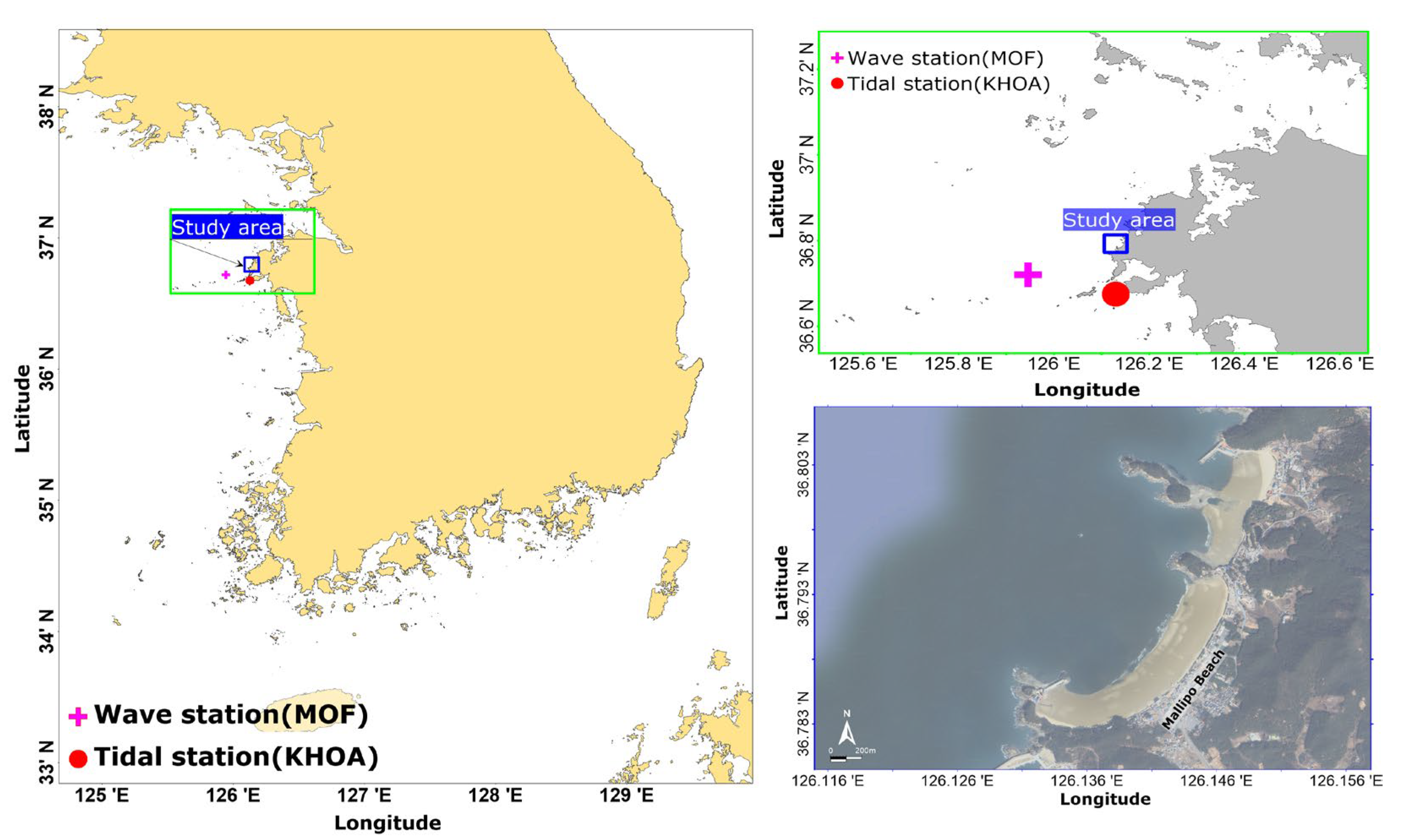
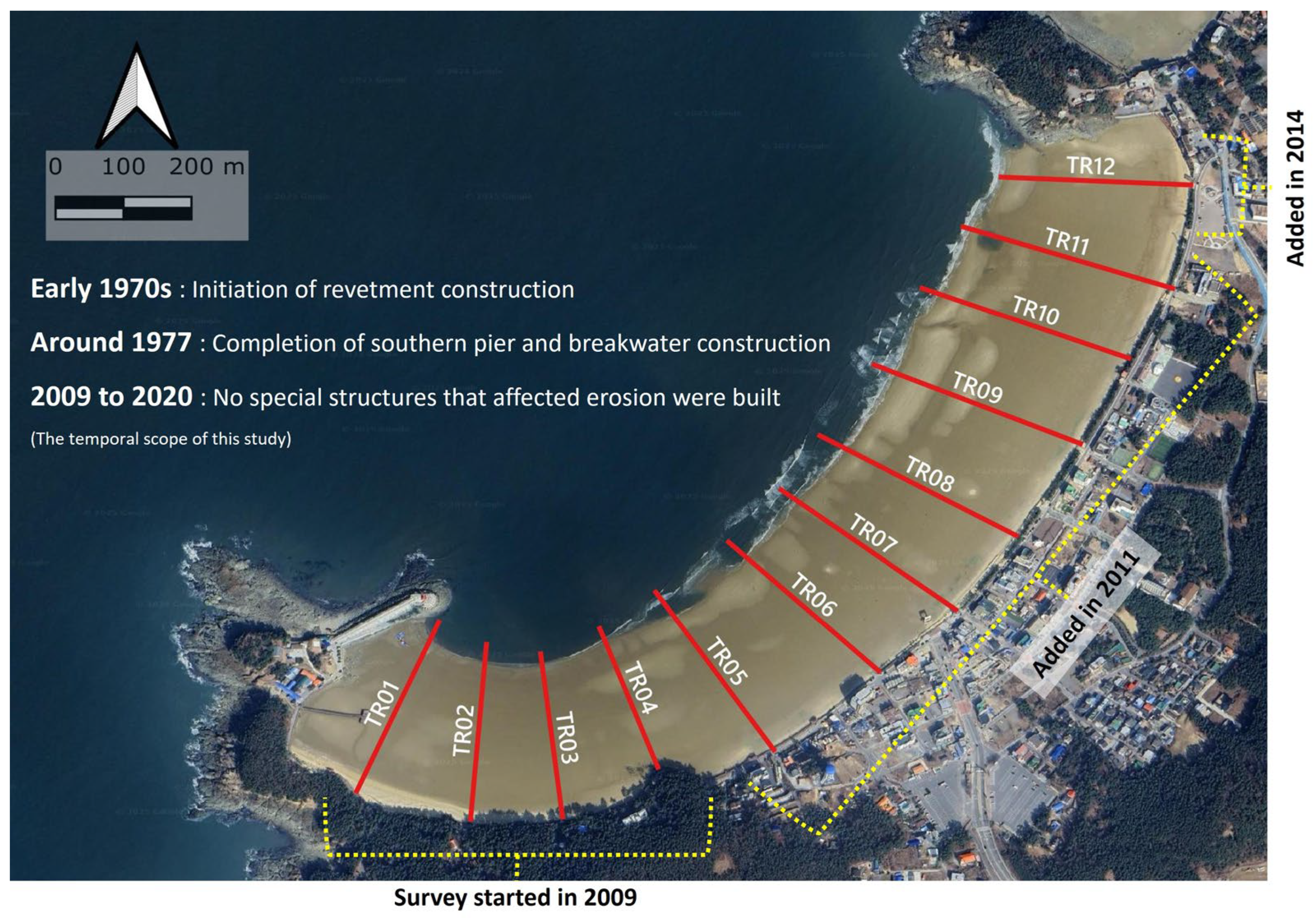
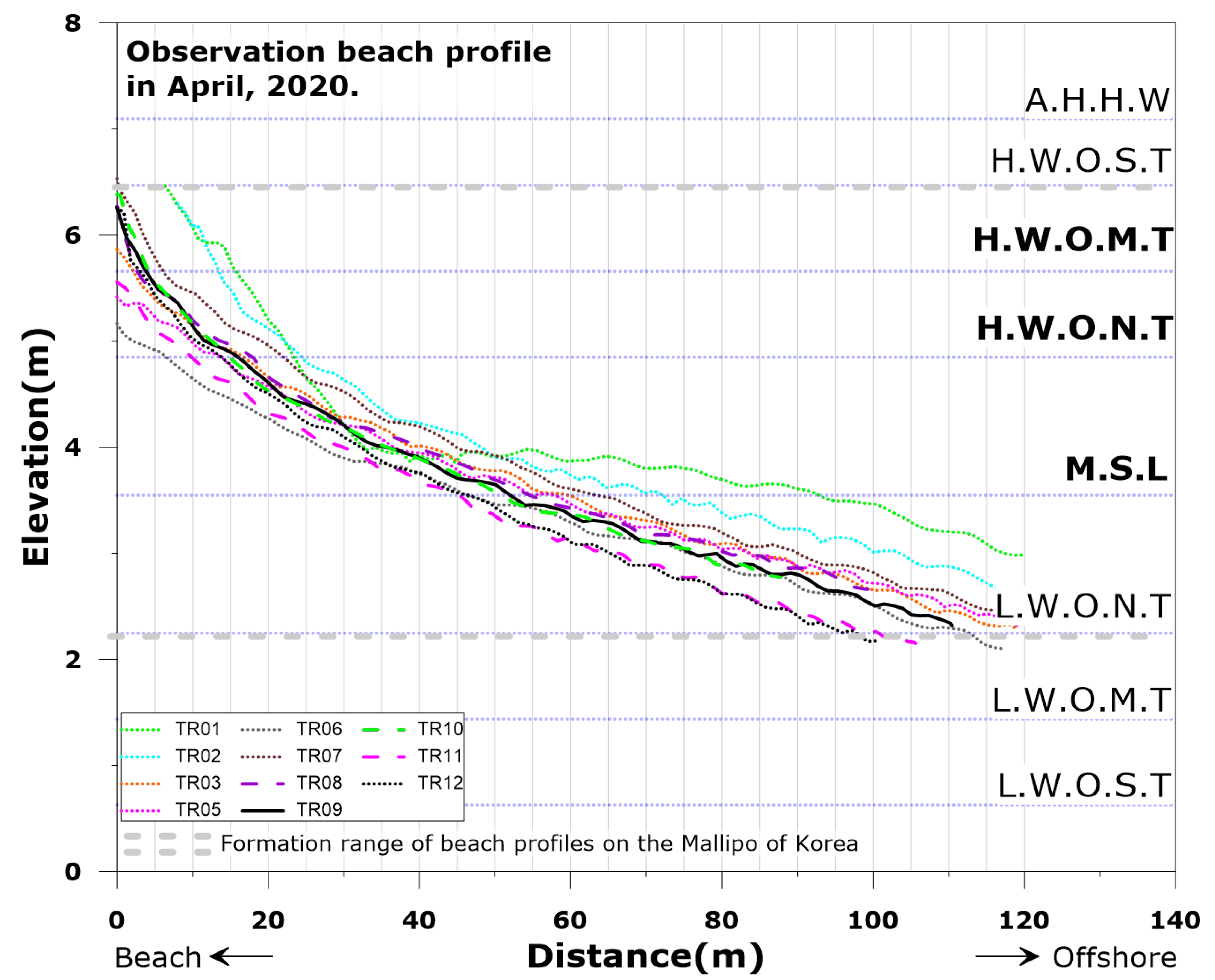

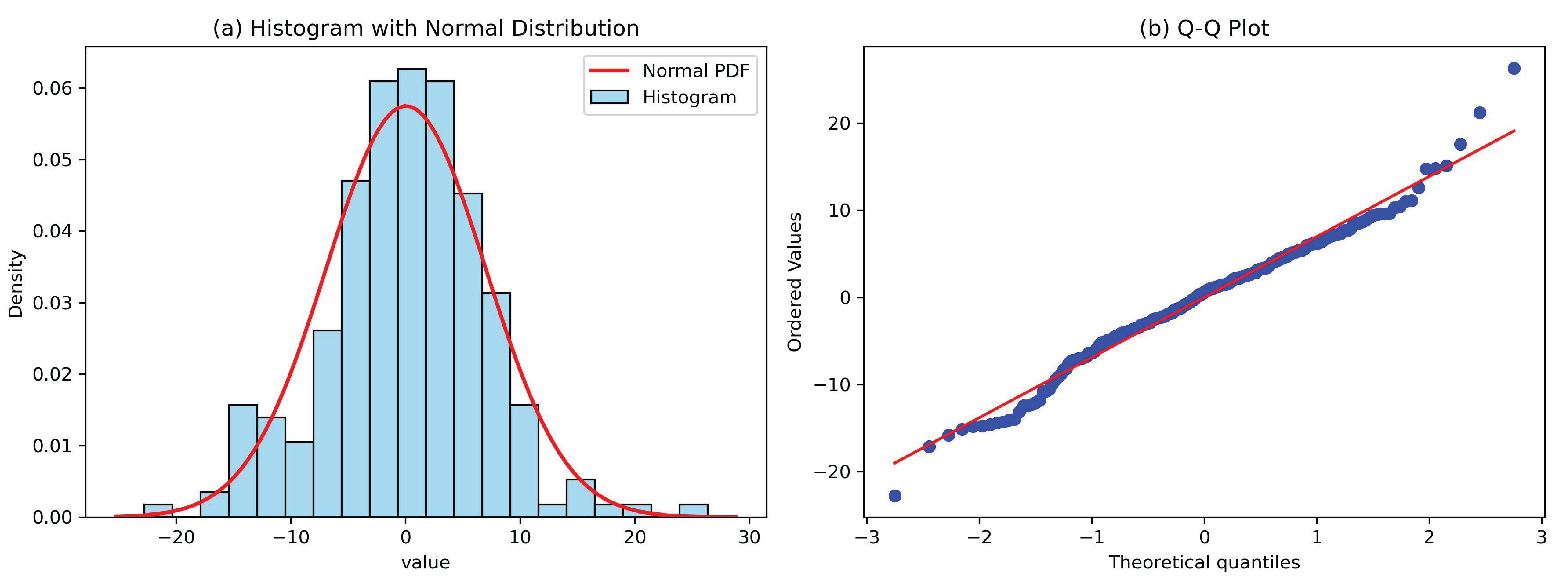
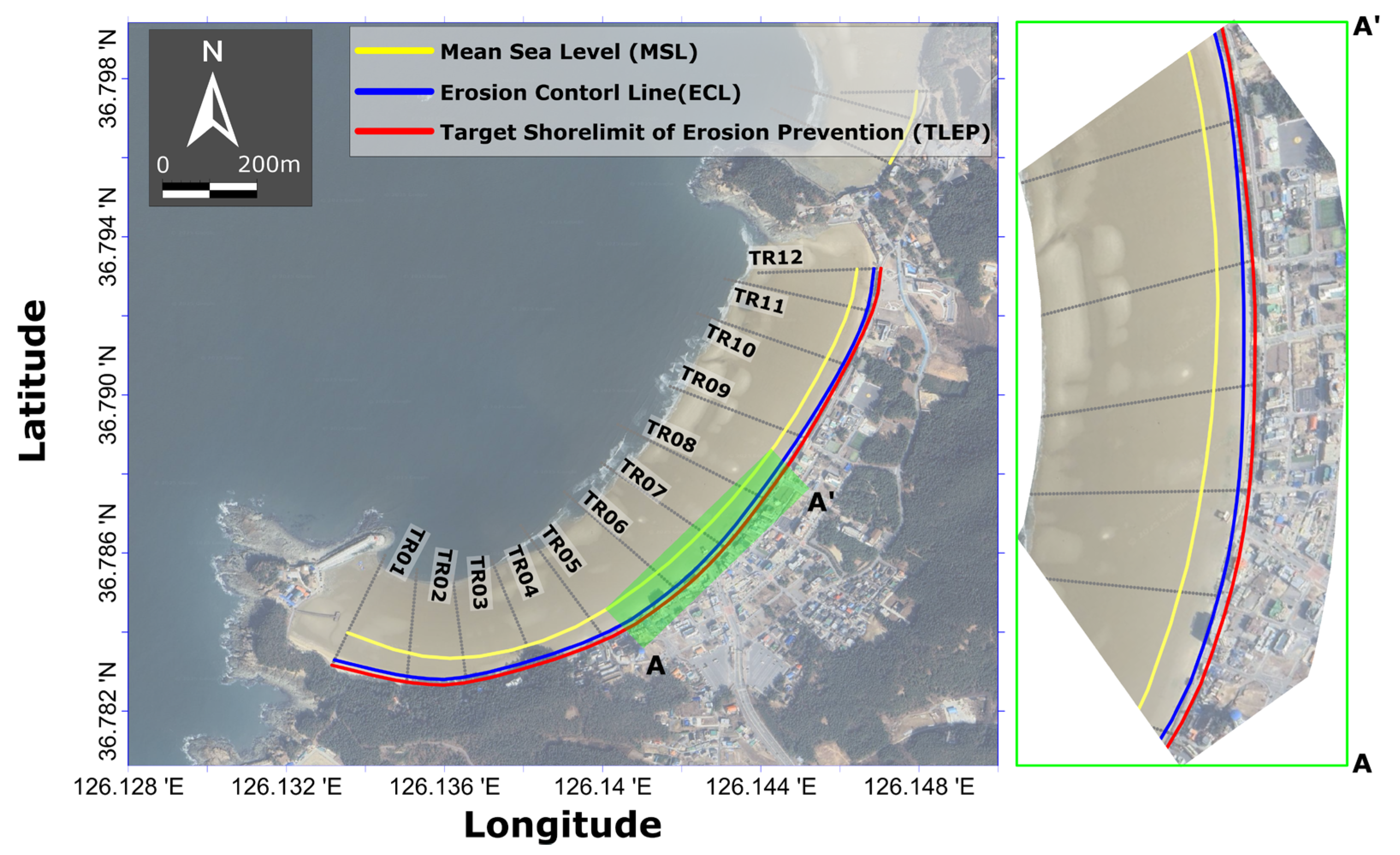
| Region | Applicable Terrain | Details |
|---|---|---|
| Samoa | Beach, bluffs, rocky shores |
|
| Marian Islands | Beach, bluffs, rocky shores |
|
| Guam | Beach, bluffs, rocky shores |
|
| Michigan | Beach, dunes, bluffs, rocky shores |
|
| Pennsylvania | Beach, bluffs |
|
| Puerto Rico | Beach, dunes, bluffs, rocky shores |
|
| Florida | Beach, dunes |
|
| Category | Definition | |
|---|---|---|
| Coastal control line for coastal management | Mean Target Shoreline (MTS) | Shoreline for the purpose of conservation of sand beach (average shoreline before development) |
| Erosion Prevention Line (EPL) | EPL for the purpose of protecting the hinterland infrastructures | |
| Performance evaluation of coastal control line | Equilibrium Shoreline (ESL) | Equilibrium shoreline that varies depending on changes in watershed and coastal environments |
| Erosion Control Line (ECL) | ECL at 30-year return period according to high waves (shoreline that varies depending on wave environment) | |
| Classification | H.W.O.M.T | H.W.O.N.T | M.S.L |
|---|---|---|---|
| Average Position(m) | 7.87 | 15.87 | 54.56 |
| Standard Deviation(m) | 2.66 | 1.78 | 4.61 |
| Transect No. | Average Position (m) | Standard Deviation (m) | 30-Year Return Period Erosion Width (m) |
|---|---|---|---|
| 1 | 15.88 | 2.89 | 10.81 |
| 2 | 15.67 | 2.48 | 8.63 |
| 3 | 6.07 | 3.28 | 12.26 |
| 5 | 4.05 | 3.96 | 14.83 |
| 6 | 0.93 | 2.05 | 7.66 |
| 7 | 10.74 | 5.18 | 19.37 |
| 8 | 10.04 | 4.36 | 16.33 |
| 9 | 9.31 | 3.60 | 13.46 |
| 10 | 7.80 | 3.76 | 14.06 |
| 11 | 6.61 | 4.71 | 17.62 |
| 12 | 10.77 | 4.48 | 16.77 |
| Transect No. | Average Position (m) | Standard Deviation (m) | 30-Year Return Period Erosion Width (m) |
|---|---|---|---|
| 1 | 23.28 | 2.21 | 8.27 |
| 2 | 24.24 | 2.49 | 9.47 |
| 3 | 16.36 | 3.35 | 12.54 |
| 5 | 13.62 | 3.85 | 14.41 |
| 6 | 6.51 | 4.24 | 15.85 |
| 7 | 22.32 | 3.85 | 14.42 |
| 8 | 19.48 | 2.22 | 8.31 |
| 9 | 18.06 | 2.10 | 7.85 |
| 10 | 16.30 | 2.40 | 8.96 |
| 11 | 14.66 | 3.83 | 14.32 |
| 12 | 19.85 | 3.72 | 13.91 |
| Transect No. | Average Position (m) | Standard Deviation (m) | 30-Year Return Period Erosion Width (m) |
|---|---|---|---|
| 1 | 96.77 | 6.00 | 22.45 |
| 2 | 79.24 | 6.58 | 24.61 |
| 3 | 62.83 | 6.33 | 23.67 |
| 4 | 6.30 | 3.43 | 12.84 |
| 5 | 57.03 | 5.86 | 21.92 |
| 6 | 49.69 | 5.58 | 20.90 |
| 7 | 61.65 | 7.10 | 26.56 |
| 8 | 52.42 | 10.15 | 37.97 |
| 9 | 45.42 | 8.23 | 30.80 |
| 10 | 47.49 | 8.33 | 31.15 |
| 11 | 42.33 | 7.89 | 29.53 |
| 12 | 44.80 | 7.10 | 26.57 |
Disclaimer/Publisher’s Note: The statements, opinions and data contained in all publications are solely those of the individual author(s) and contributor(s) and not of MDPI and/or the editor(s). MDPI and/or the editor(s) disclaim responsibility for any injury to people or property resulting from any ideas, methods, instructions or products referred to in the content. |
© 2025 by the authors. Licensee MDPI, Basel, Switzerland. This article is an open access article distributed under the terms and conditions of the Creative Commons Attribution (CC BY) license (https://creativecommons.org/licenses/by/4.0/).
Share and Cite
Hwang, S.-M.; Yoo, H.-J.; Kang, T.-S.; Kim, K.-H.; Lee, J.-L. Establishment of the Erosion Control Line from Long-Term Beach Survey Data on the Macro-Tidal Coast. J. Mar. Sci. Eng. 2025, 13, 1784. https://doi.org/10.3390/jmse13091784
Hwang S-M, Yoo H-J, Kang T-S, Kim K-H, Lee J-L. Establishment of the Erosion Control Line from Long-Term Beach Survey Data on the Macro-Tidal Coast. Journal of Marine Science and Engineering. 2025; 13(9):1784. https://doi.org/10.3390/jmse13091784
Chicago/Turabian StyleHwang, Soon-Mi, Ho-Jun Yoo, Tae-Soon Kang, Ki-Hyun Kim, and Jung-Lyul Lee. 2025. "Establishment of the Erosion Control Line from Long-Term Beach Survey Data on the Macro-Tidal Coast" Journal of Marine Science and Engineering 13, no. 9: 1784. https://doi.org/10.3390/jmse13091784
APA StyleHwang, S.-M., Yoo, H.-J., Kang, T.-S., Kim, K.-H., & Lee, J.-L. (2025). Establishment of the Erosion Control Line from Long-Term Beach Survey Data on the Macro-Tidal Coast. Journal of Marine Science and Engineering, 13(9), 1784. https://doi.org/10.3390/jmse13091784









